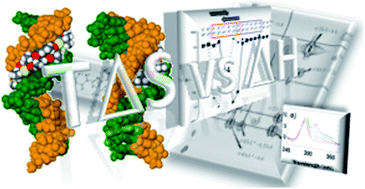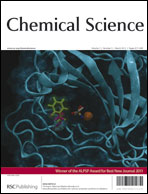DNA-sequence and structure dependence on the formation of minor groove complexes at 5′-XCYRGZ-3′, where Y = T and R = A, by the short lexitropsin thiazotropsin A are explored based on NMR spectroscopy, isothermal titration calorimetry (ITC), circular dichroism (CD) and qualitative molecular modelling. The structure and solution behaviour of the complexes are similar whether X = A, T, C or G and Z = T, A, I (inosine) or C, 5′-CCTAGI-3′ being thermodynamically the most favoured (ΔG = −11.1 ± 0.1 kcal mol−1). Binding site selectivity observed by NMR for 5′-ACTAGT-3′ in the presence of 5′- TCTAGA-3′ when both accessible sequences are concatenated in a 15-mer DNA duplex construct is consistent with thermodynamic parameters (|ΔG|ACTAGT > |ΔG|TCTAGA) measured separately for the binding sites and with predictions from modelling studies. Steric bulk in the minor groove for Z = G causes unfavourable ligand–DNA interactions reflected in lower Gibbs free energy of binding (ΔG = −8.5 ± 0.01 kcal mol−1). ITC and CD data establish that thiazotropsin A binds the ODNs with binding constants between 106 and 108 M−1 and reveal that binding is driven enthalpically through hydrogen bond formation and van der Waals interactions. The consequences of these findings are considered with respect to ligand self-association and the energetics responsible for driving DNA recognition by small molecules in the DNA minor groove.

You have access to this article
 Please wait while we load your content...
Something went wrong. Try again?
Please wait while we load your content...
Something went wrong. Try again?


 Please wait while we load your content...
Please wait while we load your content...